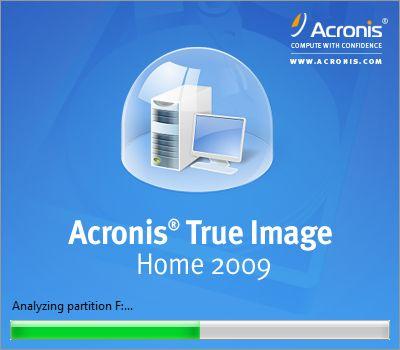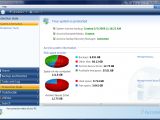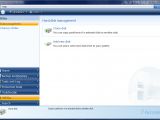Tasks and Log
This is where Acronis shows scheduled tasks, unscheduled ones and their log files containing step-by-step actions to the completion of the job. Flexibility is the key feature of the application and this menu does not run short of it either. At a right click of the mouse you can start a backup job, edit it and make the desired changes regarding the data to be protected, change the schedule to a later time, rename the job, delete it altogether or create a new backup/validation task.
The calendar gives you the possibility to move around to a different date of the year and plan the backups with ease. Logs provide a clear view over how the operations went and pinpoint the errors as well as save them on disk for future reference. But there is one small glitch if you are not used to reading between the lines: the document created is a LOG file that can easily be opened with Notepad but it will preserve all formatting parameters and you have to clear out the information yourself.
Protection State
The app provides an overall view of the state of the system via the Protection State menu. It is nothing complicated but it lets you have a good grip on three of the most important features of the software: system volume backup, bootable media and Acronis Startup Recovery Manager. If the introductory message of the page says that your system is protected and the status of all three components is green then you should have nothing to worry about.
As mentioned before, Acronis can run both online and offline backup jobs and for the latter a bootable media containing all the commands and options should be created. It sounds pretty techie, but it is actually a disc that stores a brief version of the software you can boot from and perform most of the backup jobs and other tasks as in the online correspondent.
Creating this disc can be started from under the Tools menu of the application. As with most operations in Acronis, making the rescue disk is wizard attended so you don't have to bash your brains out. The media resulted can be burned directly to a disc (CD, CD-RW, DVD, DVD-RW) or saved as an ISO file on the disk in order to be burned later.
The benefits of the rescue disc are almost as numerous as with the online application and the bootable disc provides the main backup options. When booting from it you will have the same interface so there is almost no difference between the two. Of course, options such as mounting a backup on a virtual drive, saving application and e-mail settings and others that need an online environment in order to be completed are not available.
Startup Recovery Manager is a super-useful option if you want to manage restoration tasks without the need of a rescue media or the actual software. The Recovery Manager allows you to reinstate data at boot time. For this to work you have to create a special hidden partition called Acronis Secure Zone (ASZ) where you can store backup images.
The Secure Zone is created using either unallocated space or at the expense of the free space on a volume. At any moment you can increase the size of the zone, decrease it, remove it or protect it with a password. Managing this partition can be achieved regardless of the method used to access the application (online or offline). More than this, the zone can be deactivated at any time and thus you give up the Acronis boot option.
Try and Decide
This feature instills even more faith in the application as it is one of the best ways to work on your computer with absolutely no care in the world for viruses or file damaging of any kind. Once started, it works by making all the changes in a virtual environment insulated from the rest of your computer. The creation of Acronis Secure Zone is imperative as the virtual environment is created on this partition.
With Try&Decide you can make any tests on your computer with the possibility of appending the changes (check out the system tray icon) or discarding them at reboot. Its functionality extends to installing updates, drivers, applications without any worry that these may negatively affect the system because you can chuck out any alteration.
However, there are some limitations you should take into account. During our tests working with Try&Decide negatively affected the performance of the system. Also, the virtual environment is restricted by the size of the Acronis Secure Zone. When there is no more free space on ASZ the program will alert you and compel you to make a decision of either keeping or casting away the changes.
You can work with Try&Decide for as long as you want (provided that there is enough free space on Acronis Secure Zone) but you have to keep in mind that when finished it may take quite a while to apply changes. It all depends on how many modifications have been made.
By default the protected partition is C:, the system drive on the majority systems, but you can enable a different drive, according to how it suits you best. As for the alerts regarding the free disk space remaining in the virtual environment, the application offers you the possibility to enable a notification once a user-defined amount is reached. Also, you can receive a notification on the time elapsed since Try&Decide mode started.
Utilities
For those in need of a comfortable way of transferring all the data on a system drive due to insufficient space to another, larger disk, Acronis gives a hand with its Disk Cloning feature. It purpose fits the need exactly, allowing you to move your data off a system drive to another disk easy and with clear wizard-assisted steps. Mind that this utility is designed only for hard disks and will clone them with partitions and all there is on them. Existing partitions on the source disk are automatically adjusted to fit the target in a completely automatic process.
You can also choose the manual procedure, which gives you full control over the entire cloning process by deciding how the data should be transferred: As is (a new volume is created for each old one with the same size, type, file system and label), Proportional (the new disk is proportionally distributed between cloned volumes) and Manual (you get to set the new size and other parameters).
If for some reason you only want to keep the system intact on the old disk and just rake data on a new one, then Acronis lets you add a new storage device guided by a wizard. The procedure is as simple as any other operation in the application, so there is nothing to worry about, save for the fact that if the new disk is partitioned it must be deleted first (this will not happen without warning).
Leaving the disk management of the Utilities menu aside, we pass to the cleanup instruments. Acronis is equipped with a drive cleaner, file shredder and system file cleaner. They are all similar in their activity but have different targets. Drive Cleanser's action is only affecting drives and disks, File Shredder lets you destroy important data beyond recovery and System Cleanup unclogs the computer of useless system components such as temporary data, wipes free disk space, erases the Windows Run list or open/saved file history.
Data destruction for all three tools is the same and includes some of the best standard wiping algorithms like German, Russian and US standards, NAVSO, US DoD (Department of Defense) 5220.22-M, Peter Gutmann's 35 pass wiping or Bruce Schenier's 7 pass overwrite. In the case of System Clean-Up you can customize the wiping algorithm for each available section. Getting to set this is indeed a bit frustrating as there is no clear path on the steps to get there and the pop-up screens are almost identical, leading you into a bit of a haze.
The algorithms presented above are not your only choice as the program allows creating a customized wipe rule letting you decide on the parameters for the passes used to erase the data.
Search is the last menu in the list and contains a surprising option. It lets you search the actual backup archive for files and folders. The process relies entirely on Windows Search and Google Desktop indexing services so if you have either of them finding a file in the archive is almost guaranteed. But don't jump for joy just yet because in order to be able to perform TIB and ZIP archive search you will have to enable the indexing of the backup image first.
Of course the results of the search depend entirely on the two adjacent in purpose applications. So, should you happen not to find a file you definitely know is there, do not blame Acronis, but the indexing service you use. The actual search is not quite as fast a process as one would expect and in our case it generally took a while to list all the results.
If you for some reason deem all backup and restore options too complicated and you just want a fast, clean, comfy backup of a drive, all there is to it is to appeal to One Click Protection. It is a quick way to create a backup task for ulterior recovery of the system with a single click. One Click Protection acts solely on the system volume and Master Boot Record so upon restoration everything comes back to the initial healthy state.
The options for this instrument are brief and include only refreshing the backup at a user-defined time interval. Also, you get to establish the storage location, which can be anything from a local drive to a network place or FTP location.
The Good
It can create images from any drive you face it with as well as the settings of some of the most popular applications on the market. Each action is neatly added to a log, which you can consult at any time.
Backup activities can be scheduled to start at a user-defined period and should you change your mind the task can be edited or deleted altogether.
The application can create a hidden partition, out of disk unallocated space or free space of a partition, to shelter backup archives safely and protected from intentional or unintentional accidents. Secure Zone also doubles as a virtual environment for testing purposes.
Utilities provided cover drive wiping, file deletion and cleaning system of clutter by using 7 strong data wipe algorithms and at the same time offering you the possibility to create your own algorithm.
Disk cloning for an exact replica of a storage device on a new disk comes in handy if you want to avoid installing the operating system on the new device.
Backup image search capabilities rely on Windows Search and Google Desktop, but they are of extraordinary use for looking for a specific file in a TIB or ZIP archive.
The Bad
Logs can be saved on the computer, but it sure is a difficult job reading them in Notepad as Acronis does not support log import and the user is confined to reading between all XML code lines.
We did not experience major pitfalls of the software throughout our testing but during an offline restoration it did render available space on a partition somewhere around 8 billion TB.
The Truth
Despite all the trouble it gave us with the HP laptop Acronis did create a valid image of the system drive, thus allowing us recovery of all necessary data.
Through its slick looking interface, wizard-driven tasks and range of utilities integrated it addresses all types of users offering the possibility for both online and offline backup and restore jobs.
Startup Recovery Manager lets you initiate Acronis True Image without the installation of the software on the computer or the need of the rescue disc making the entire procedure (backup or restore) even more comfortable. It allows you to access the offline version of the application at boot time.
Acronis makes for a complete backup and restore solution regardless of the type of data you have (entire disks, individual drives, data or application settings).
 14 DAY TRIAL //
14 DAY TRIAL // 




























